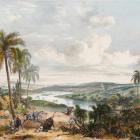Traveling naturalists and artists took advantage of the opening of Brazilian borders in 1808 by the Portuguese Crown, which moved to Rio de Janeiro during the Napoleonic Wars. They were interested in describing, botanizing, and collecting in a country that remained mostly unknown outside the Portuguese Empire. Most travelers remained on the coast, especially in Rio de Janeiro, which resulted in multiple accounts and images of the surrounding rainforests and coastal landscapes. The inner Highlands (planalto) of Central Brazil were more difficult to reach due to long distances and travel conditions but some visited the mining districts, where the coastal rainforests (Mata Atlântica) change into drier vegetations as people advance towards the interior.
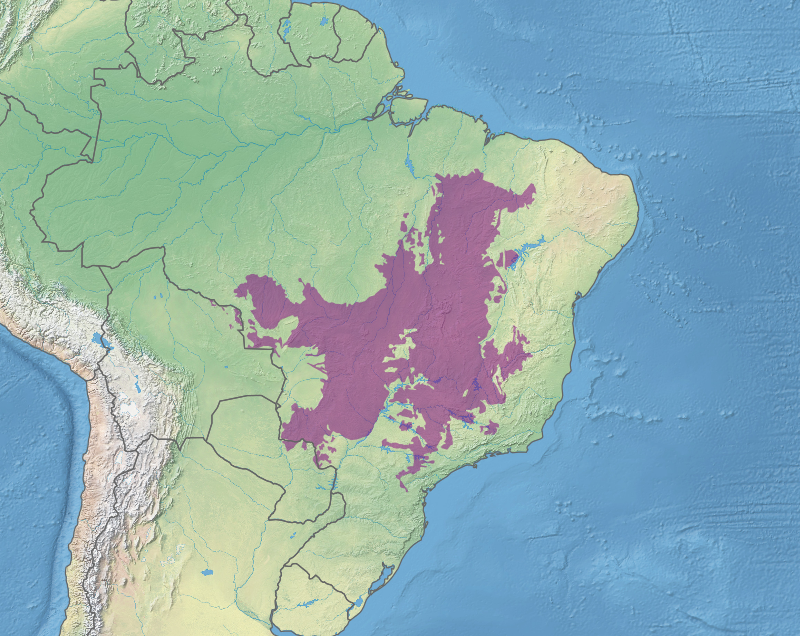
Map of the Cerrado ecoregion as delineated by the World Wide Fund for Nature (WWF).
Map of the Cerrado ecoregion as delineated by the World Wide Fund for Nature (WWF).
Map by Terpsichores, 2012.
Accessed via Wikimedia on 14 April 2021. Click here to view source.
 This work is licensed under a Creative Commons Attribution-ShareAlike 3.0 Unported License.
This work is licensed under a Creative Commons Attribution-ShareAlike 3.0 Unported License.
Early nineteenth-century inhabitants and naturalists used a rich lexicon of words to refer to the variety of vegetation types of the Highlands. Campos was a common term for the mosaic of grasslands, pastures, savannahs, and woodlands in a region characterized by rainy summers and dry winters—now called the Cerrado ecoregion. It has been occupied for millennia by native peoples and since the eighteenth century by European settlers and enslaved and freed Africans and their descendants, who were attracted by mining and cattle ranching. This accounts for the hybrid aspect of the vegetation, with plants adapted to natural fires and the ranchers’ annual fire regime, and the intrusion of invasive grasses—processes that the French botanist Auguste de Saint-Hilaire and the Danish naturalist Peter W. Lund were already documenting at the time.
Changes in visual culture and natural history stimulated the production of picturesque images of typical landscapes, related to the publication of illustrated travel accounts, discussed by art historians Bernard Smith, Barbara Stafford, and Ana Maria Belluzo. Alexander von Humboldt (1769–1859) played an important role in renewing the European interest in the tropical Americas with his ideas for composing holistic views of nature, favoring botanical-geographic studies of particular places combined with sensory experiences from the field, in dialogue with travelers. Although iconography of the Brazilian Highlands at that time depicts most often towns, two Bavarian travelers are among the few who recorded the vegetation of this region, as well as its environmental transformations—in direct exchange with Humboldt.
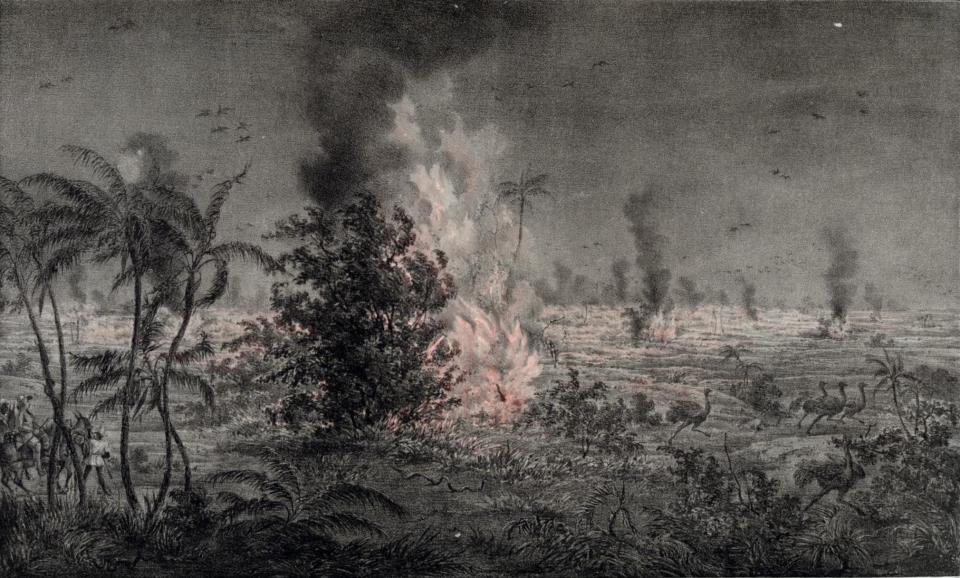
The burning of the campos vegetation in Minas Gerais, Brazil. Carl Friedrich von Martius, c. 1840.
The burning of the campos vegetation in Minas Gerais, Brazil. Carl Friedrich von Martius, c. 1840.
Carl Friedrich von Martius, August Wilhelm Eichler, and Ignatz Urban (eds.), Flora Brasiliensis, vol. 1, book 1. (Munich and Leipzig: R. Oldenbourg, Frid. Fleischer, 1906).
 This work is licensed under a Creative Commons Public Domain Mark 1.0 License.
This work is licensed under a Creative Commons Public Domain Mark 1.0 License.
The botanist Carl Friedrich von Martius (1794–1868) traveled to Brazil with Johann Baptist von Spix (1781–1826) as part of a scientific expedition (1817–1820) financed by the Bavarian Crown, visiting several parts of the country. The artist Johann Moritz Rugendas (1802–1858) traveled in 1822 as part of an expedition of the Russian Academy of Sciences, directed by naturalist Georg von Langsdorff—but later left it, spending months in the mining province of Minas Gerais. An illustrated album for Martius and Spix’s Travels in Brazil was produced in Munich from Martius’s drafts. Rugendas’s Voyage Pittoresque dans le Brésil [Picturesque voyage to Brazil] contains lithographs produced at a Parisian printing house with his involvement. Rugendas also collaborated with Martius, producing landscape illustrations for his botanical compendia Historia Naturalis Palmarum and Flora Brasiliensis.
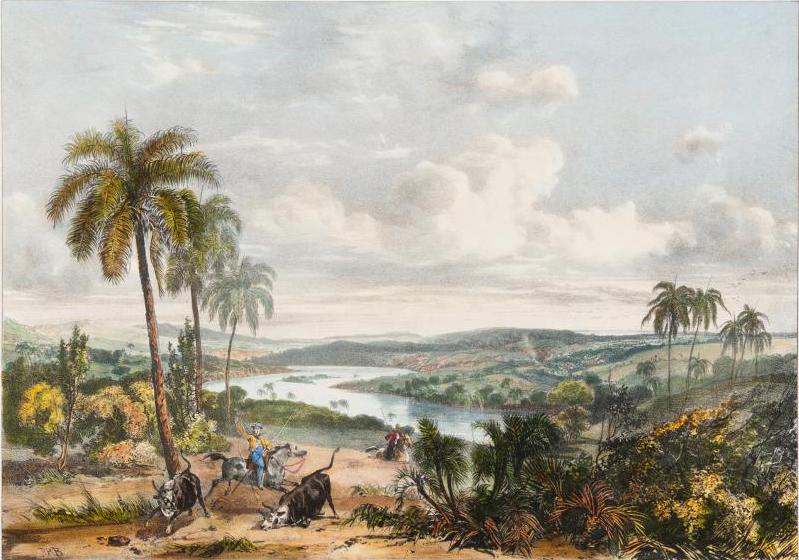
Illustration of vegetation and settler life in Minas Gerais. Johann Moritz Rugendas, Victor Adam, and Richard Parkes Bonington, 1835.
Illustration of vegetation and settler life in Minas Gerais. Johann Moritz Rugendas, Victor Adam, and Richard Parkes Bonington, 1835.
Colored lithograph.
Johann Moritz Rugendas, Voyage Pittoresque dans le Brésil (Paris: Engelmann & Cie, 1835).
 This work is licensed under a Creative Commons Public Domain Mark 1.0 License.
This work is licensed under a Creative Commons Public Domain Mark 1.0 License.
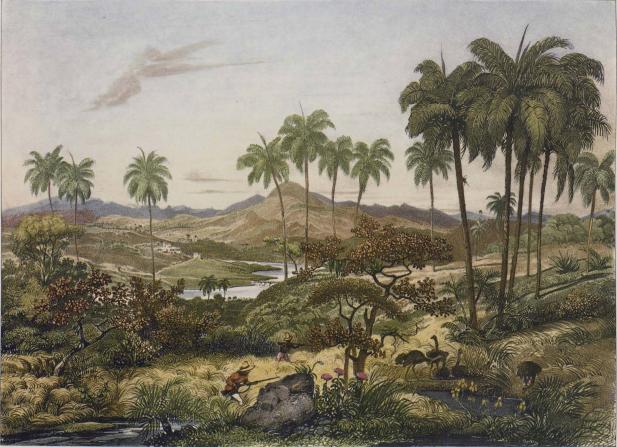
Illustration of vegetation in Minas Gerais. Johann Moritz Rugendas and Alexis Victor Joly, 1835.
Illustration of vegetation in Minas Gerais. Johann Moritz Rugendas and Alexis Victor Joly, 1835.
Colored lithograph.
Johann Moritz Rugendas, Voyage Pittoresque dans le Brésil (Paris: Engelmann & Cie, 1835).
 This work is licensed under a Creative Commons Public Domain Mark 1.0 License.
This work is licensed under a Creative Commons Public Domain Mark 1.0 License.
Geographers Felix Driver and Luciana Martins have discussed the intense production of a “tropicality” by travelers—the tropical regions as an elsewhere to the temperate world—a process characterized by generalizations but also by the typification of particular landscapes. So how were the Brazilian Highlands particularly characterized?
Eighteenth-century Portuguese expeditions produced images of the region focusing on geographical aspects, such as forested rivers and human settlements, or botanical and zoological studies of individual species. Nineteenth-century naturalists were the first to illustrate the Highlands according to their physiognomy, combining vegetation, fauna, topography, geology, and human activities. According to Barbara Stafford, the new visual language of natural history at the time focused on geological change, which could be interpreted from strange rock formations, eruptions, and the shape and organization of mountain ranges. In an illustrated mountainous landscape of Minas Gerais in Spix and Martius’s Travels in Brazil, we see geological and topographic features, strange rocks jutting out from the soil, with a few typical bushes and trees dotting the image.
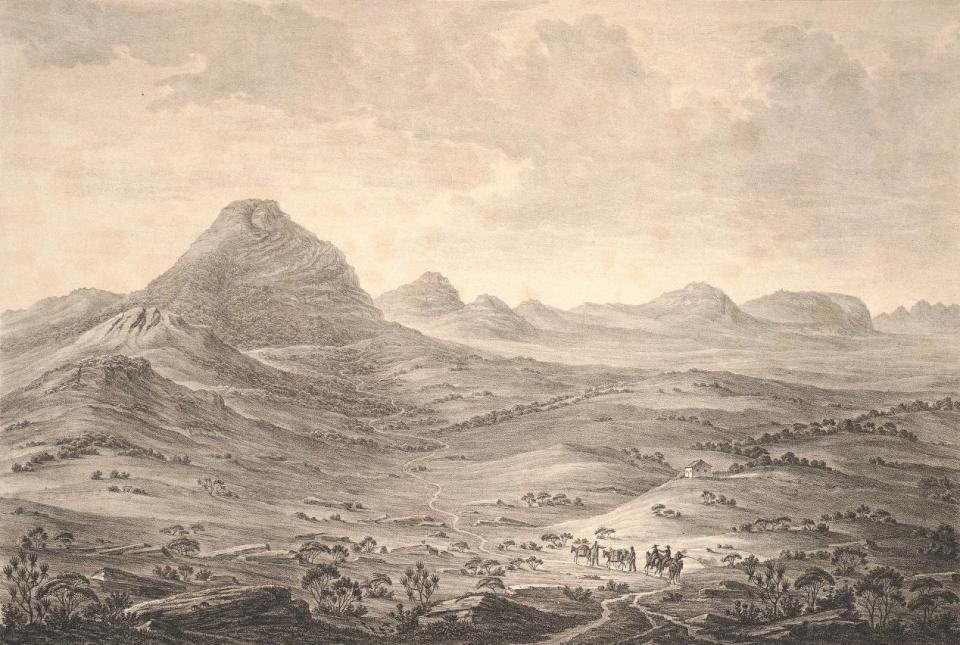
Illustration of a mountain range in Minas Gerais, Brazil. Carl Friedrich von Martius and F. W. von Couven, c. 1831.
Illustration of a mountain range in Minas Gerais, Brazil. Carl Friedrich von Martius and F. W. von Couven, c. 1831.
J. B. von Spix and C. F. von Martius, Reise in Brasilien auf Befehl Sr. Majestät Maximilian Joseph I., Königs von Baiern, in den Jahren 1817 bis 1820 gemacht und beschrieben (Munich: Lindauer, 1831).
 This work is licensed under a Creative Commons Public Domain Mark 1.0 License.
This work is licensed under a Creative Commons Public Domain Mark 1.0 License.
In Rugendas, images of rainforests and campos advance Humboldt’s ideas, combining sensory experiences from the journey with a special focus on the diversity of tropical vegetations. Travelers mention the good feeling of leaving the dense rainforests, coming out into the vast grasslands, and his images of forests show a dark, enclosed, and chaotic plethora of plants, while the campos were illustrated as vast streches towards the horizon with clear skies, presenting the feeling of immensity travelers described in their texts.
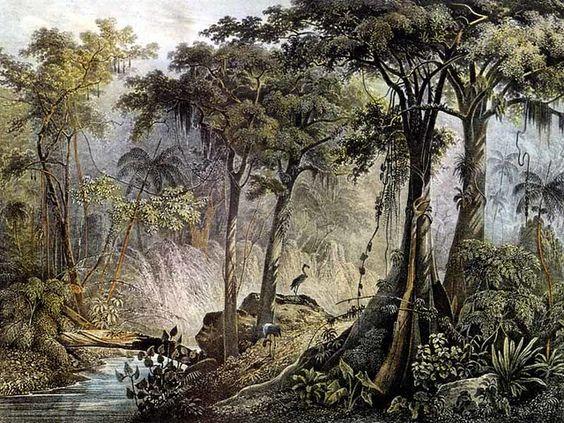
Illustration of a rainforest. Johann Moritz Rugendas and Alexis Victor Joly, 1835.
Illustration of a rainforest. Johann Moritz Rugendas and Alexis Victor Joly, 1835.
Colored lithograph.
Johann Moritz Rugendas, Voyage Pittoresque dans le Brésil (Paris: Engelmann & Cie, 1835).
 This work is licensed under a Creative Commons Public Domain Mark 1.0 License.
This work is licensed under a Creative Commons Public Domain Mark 1.0 License.
They annotated the changing visual characteristics of a variety of landscapes as they traveled from one to next, selecting elements to produce different environmental histories of each region. Rainforests are presented as a virgin landscape, despite the presence of human inhabitants, with fallen tree trunks serving as natural bridges and palm trees as columns, as in a timeless Golden Age. On the other hand, images of campos are filled with carefully studied grasses, bushes, and palm and pine trees, but also documented the advancing colonization of the Highlands. Rather than just static vegetation, there is movement in the scenes in the shape of cattle ranching, hunting, the burning of grasslands, and travelers’ activities, such as collecting natural specimens. In these vast expanses, action falls on men dominating bulls, wild birds, and grasslands with lassos, weapons, and fire. These images have since been circulating among Brazilian cultural elites and eerily anticipate contemporary environmental attitudes towards the Cerrado, most often imagined as an open land for agribusiness exploitation.
How to cite
Bailão, André S. “The Brazilian Campos in Nineteenth-Century Landscape Art.” Environment & Society Portal, Arcadia (Spring 2021), no. 15. Rachel Carson Center for Environment and Society. doi:10.5282/rcc/9279.
ISSN 2199-3408
Environment & Society Portal, Arcadia
 This work is licensed under a Creative Commons Attribution 4.0 International License.
This work is licensed under a Creative Commons Attribution 4.0 International License.
2021 André S. Bailão
This refers only to the text and does not include any image rights.
Please click on an image to view its individual rights status.
- Belluzo, Ana Maria de Moraes. O Brasil dos Viajantes [The travelers’ Brazil]. São Paulo: Objetiva, Metalivros, Fundação Odebrecht, 2000.
- Driver, Felix, and Luciana Martins, eds. Tropical Visions in an Age of Empire. Chicago: The University of Chicago Press, 2005.
- Martius, Carl Friedrich Philipp von, August Wilhelm Eichler, and Ignatz Urban, eds. Flora Brasiliensis. Vol. 1, Book 1. Munich and Leipzig: R. Oldenbourg, Frid. Fleischer, 1906.
- Rugendas, Johann Moritz. Voyage Pittoresque dans le Brésil [Picturesque voyage to Brazil]. Translated by M. De Golbéry. Paris: Engelmann & Cie, 1835. http://catalogue.bnf.fr/ark:/12148/cb31269136j.
- Smith, Bernard. European Vision and the South Pacific. 2nd edition. New Haven: Yale University Press, 1985.
- Spix, Johann Baptist von, and Carl Friedrich Philipp von Martius. Reise in Brasilien auf Befehl Sr. Majestät Maximilian Joseph I., Königs von Baiern, in den Jahren 1817 bis 1820 gemacht und beschrieben [Travels in Brazil in the Years 1817–1820]. Munich: Lindauer, 1831. https://www.biodiversitylibrary.org/item/55383.
- Stafford, Barbara Maria. Voyage into Substance: Art, Science, Nature, and the Illustrated Travel Account, 1760–1840. Cambridge: The MIT Press, 1984.



